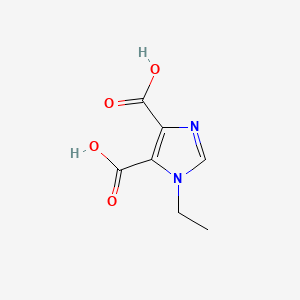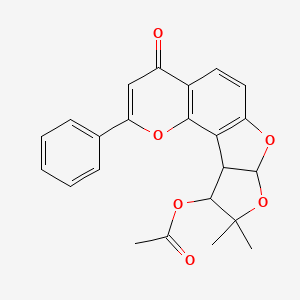
Mechlorethamine
Descripción general
Descripción
Originalmente se derivó de la investigación del gas mostaza y desde entonces se ha convertido en una piedra angular en el tratamiento de varios cánceres, incluida la enfermedad de Hodgkin, el linfosarcoma y ciertos tipos de leucemia . La mostaza de nitrógeno es conocida por su capacidad para interferir con la replicación del ADN, lo que lleva a la muerte celular.
Métodos De Preparación
Rutas sintéticas y condiciones de reacción: La mostaza de nitrógeno se sintetiza mediante la reacción de etilenimina con ácido clorhídrico, seguida de la adición de metilamina. Las condiciones de reacción generalmente implican:
Temperatura: Controlada a alrededor de 0-5 °C para evitar la descomposición.
Solvente: A menudo se lleva a cabo en un medio acuoso.
Purificación: El producto se purifica mediante destilación o recristalización.
Métodos de producción industrial: En entornos industriales, la mostaza de nitrógeno se produce en reactores a gran escala con controles estrictos para garantizar la pureza y la seguridad. El proceso involucra:
Procesamiento por lotes: Para mantener el control sobre las condiciones de reacción.
Medidas de seguridad: Debido a su naturaleza tóxica, las instalaciones de producción están equipadas con sistemas avanzados de ventilación y contención.
Análisis De Reacciones Químicas
Tipos de reacciones: La mostaza de nitrógeno experimenta varios tipos de reacciones químicas, que incluyen:
Alquilación: Forma enlaces covalentes con el ADN, lo que lleva a la reticulación y la ruptura de las cadenas.
Hidrólisis: En entornos acuosos, la mostaza de nitrógeno puede hidrolizarse para formar compuestos menos activos.
Reactivos y condiciones comunes:
Reacciones de alquilación: Generalmente se llevan a cabo en presencia de ADN u otros nucleófilos.
Hidrólisis: Ocurre fácilmente en agua o soluciones acuosas.
Principales productos formados:
Aductos de ADN: Los principales productos de las reacciones de alquilación con el ADN.
Derivados hidrolizados: Resultante de reacciones de hidrólisis.
Aplicaciones Científicas De Investigación
La mostaza de nitrógeno tiene una amplia gama de aplicaciones en la investigación científica:
Química: Se utiliza como un compuesto modelo para estudiar reacciones de alquilación e interacciones con el ADN.
Biología: Se emplea en la investigación sobre mecanismos de reparación del ADN y mutagénesis.
Medicina: Un componente clave en los regímenes de quimioterapia para el tratamiento de varios cánceres.
Industria: Se utiliza en la síntesis de otros compuestos farmacéuticos
Mecanismo De Acción
La mostaza de nitrógeno ejerce sus efectos a través de la formación de iones carbonio, que alquilatan las bases del ADN. Esto lleva a la formación de enlaces cruzados intercatenarios e intracatenarios, lo que resulta en una codificación errónea, rotura de las cadenas y, en última instancia, la muerte celular. Los principales objetivos moleculares son los átomos de nitrógeno N7 de las bases guanina en el ADN .
Compuestos similares:
Ciclofosfamida: Otro agente alquilante utilizado en la quimioterapia.
Clorambucil: Un compuesto relacionado con mecanismos de acción similares.
Melfalán: Se utiliza en el tratamiento del mieloma múltiple y el cáncer de ovario.
Comparación:
Potencia: La mostaza de nitrógeno es altamente potente y actúa rápidamente en comparación con algunos otros agentes alquilantes.
Toxicidad: Tiene un perfil de toxicidad más alto, lo que requiere un manejo y una administración cuidadosos.
La mostaza de nitrógeno sigue siendo un compuesto fundamental en el campo de la quimioterapia, con investigaciones en curso que exploran su potencial y aplicaciones completos.
Comparación Con Compuestos Similares
Cyclophosphamide: Another alkylating agent used in chemotherapy.
Chlorambucil: A related compound with similar mechanisms of action.
Melphalan: Used in the treatment of multiple myeloma and ovarian cancer.
Comparison:
Potency: Mechlorethamine is highly potent and acts rapidly compared to some other alkylating agents.
Toxicity: It has a higher toxicity profile, necessitating careful handling and administration.
Mechanism: While all these compounds alkylate DNA, this compound’s rapid action and high reactivity make it unique.
This compound remains a critical compound in the field of chemotherapy, with ongoing research exploring its full potential and applications.
Propiedades
IUPAC Name |
2-chloro-N-(2-chloroethyl)-N-methylethanamine | |
|---|---|---|
| Source | PubChem | |
| URL | https://pubchem.ncbi.nlm.nih.gov | |
| Description | Data deposited in or computed by PubChem | |
InChI |
InChI=1S/C5H11Cl2N/c1-8(4-2-6)5-3-7/h2-5H2,1H3 | |
| Source | PubChem | |
| URL | https://pubchem.ncbi.nlm.nih.gov | |
| Description | Data deposited in or computed by PubChem | |
InChI Key |
HAWPXGHAZFHHAD-UHFFFAOYSA-N | |
| Source | PubChem | |
| URL | https://pubchem.ncbi.nlm.nih.gov | |
| Description | Data deposited in or computed by PubChem | |
Canonical SMILES |
CN(CCCl)CCCl | |
| Source | PubChem | |
| URL | https://pubchem.ncbi.nlm.nih.gov | |
| Description | Data deposited in or computed by PubChem | |
Molecular Formula |
C5H11Cl2N | |
| Record name | MECHLORETHAMINE | |
| Source | CAMEO Chemicals | |
| URL | https://cameochemicals.noaa.gov/chemical/5046 | |
| Description | CAMEO Chemicals is a chemical database designed for people who are involved in hazardous material incident response and planning. CAMEO Chemicals contains a library with thousands of datasheets containing response-related information and recommendations for hazardous materials that are commonly transported, used, or stored in the United States. CAMEO Chemicals was developed by the National Oceanic and Atmospheric Administration's Office of Response and Restoration in partnership with the Environmental Protection Agency's Office of Emergency Management. | |
| Explanation | CAMEO Chemicals and all other CAMEO products are available at no charge to those organizations and individuals (recipients) responsible for the safe handling of chemicals. However, some of the chemical data itself is subject to the copyright restrictions of the companies or organizations that provided the data. | |
| Source | PubChem | |
| URL | https://pubchem.ncbi.nlm.nih.gov | |
| Description | Data deposited in or computed by PubChem | |
Related CAS |
126-85-2 (N-oxide), 302-70-5 (N-oxide, hydrochloride), 55-86-7 (hydrochloride) | |
| Record name | Mechlorethamine | |
| Source | ChemIDplus | |
| URL | https://pubchem.ncbi.nlm.nih.gov/substance/?source=chemidplus&sourceid=0000051752 | |
| Description | ChemIDplus is a free, web search system that provides access to the structure and nomenclature authority files used for the identification of chemical substances cited in National Library of Medicine (NLM) databases, including the TOXNET system. | |
DSSTOX Substance ID |
DTXSID2020975 | |
| Record name | Nitrogen mustard | |
| Source | EPA DSSTox | |
| URL | https://comptox.epa.gov/dashboard/DTXSID2020975 | |
| Description | DSSTox provides a high quality public chemistry resource for supporting improved predictive toxicology. | |
Molecular Weight |
156.05 g/mol | |
| Source | PubChem | |
| URL | https://pubchem.ncbi.nlm.nih.gov | |
| Description | Data deposited in or computed by PubChem | |
Physical Description |
Mobile liquid; faint odor of herring. Used as a drug for the treatment of cancer. Formerly used as a gas warfare agent., Colorless to pale yellow, oily liquid with a faint soapy odor or fruity odor at high concentrations; [ATSDR-MMG], Solid | |
| Record name | MECHLORETHAMINE | |
| Source | CAMEO Chemicals | |
| URL | https://cameochemicals.noaa.gov/chemical/5046 | |
| Description | CAMEO Chemicals is a chemical database designed for people who are involved in hazardous material incident response and planning. CAMEO Chemicals contains a library with thousands of datasheets containing response-related information and recommendations for hazardous materials that are commonly transported, used, or stored in the United States. CAMEO Chemicals was developed by the National Oceanic and Atmospheric Administration's Office of Response and Restoration in partnership with the Environmental Protection Agency's Office of Emergency Management. | |
| Explanation | CAMEO Chemicals and all other CAMEO products are available at no charge to those organizations and individuals (recipients) responsible for the safe handling of chemicals. However, some of the chemical data itself is subject to the copyright restrictions of the companies or organizations that provided the data. | |
| Record name | Nitrogen mustard (HN-2) | |
| Source | Haz-Map, Information on Hazardous Chemicals and Occupational Diseases | |
| URL | https://haz-map.com/Agents/1512 | |
| Description | Haz-Map® is an occupational health database designed for health and safety professionals and for consumers seeking information about the adverse effects of workplace exposures to chemical and biological agents. | |
| Explanation | Copyright (c) 2022 Haz-Map(R). All rights reserved. Unless otherwise indicated, all materials from Haz-Map are copyrighted by Haz-Map(R). No part of these materials, either text or image may be used for any purpose other than for personal use. Therefore, reproduction, modification, storage in a retrieval system or retransmission, in any form or by any means, electronic, mechanical or otherwise, for reasons other than personal use, is strictly prohibited without prior written permission. | |
| Record name | Mechlorethamine | |
| Source | Human Metabolome Database (HMDB) | |
| URL | http://www.hmdb.ca/metabolites/HMDB0015025 | |
| Description | The Human Metabolome Database (HMDB) is a freely available electronic database containing detailed information about small molecule metabolites found in the human body. | |
| Explanation | HMDB is offered to the public as a freely available resource. Use and re-distribution of the data, in whole or in part, for commercial purposes requires explicit permission of the authors and explicit acknowledgment of the source material (HMDB) and the original publication (see the HMDB citing page). We ask that users who download significant portions of the database cite the HMDB paper in any resulting publications. | |
Boiling Point |
189 °F at 18 mmHg (EPA, 1998), 87°C at 1.80E+01 mm Hg, 87 °C @ 18 mm Hg | |
| Record name | MECHLORETHAMINE | |
| Source | CAMEO Chemicals | |
| URL | https://cameochemicals.noaa.gov/chemical/5046 | |
| Description | CAMEO Chemicals is a chemical database designed for people who are involved in hazardous material incident response and planning. CAMEO Chemicals contains a library with thousands of datasheets containing response-related information and recommendations for hazardous materials that are commonly transported, used, or stored in the United States. CAMEO Chemicals was developed by the National Oceanic and Atmospheric Administration's Office of Response and Restoration in partnership with the Environmental Protection Agency's Office of Emergency Management. | |
| Explanation | CAMEO Chemicals and all other CAMEO products are available at no charge to those organizations and individuals (recipients) responsible for the safe handling of chemicals. However, some of the chemical data itself is subject to the copyright restrictions of the companies or organizations that provided the data. | |
| Record name | Mechlorethamine | |
| Source | DrugBank | |
| URL | https://www.drugbank.ca/drugs/DB00888 | |
| Description | The DrugBank database is a unique bioinformatics and cheminformatics resource that combines detailed drug (i.e. chemical, pharmacological and pharmaceutical) data with comprehensive drug target (i.e. sequence, structure, and pathway) information. | |
| Explanation | Creative Common's Attribution-NonCommercial 4.0 International License (http://creativecommons.org/licenses/by-nc/4.0/legalcode) | |
| Record name | MECHLORETHAMINE | |
| Source | Hazardous Substances Data Bank (HSDB) | |
| URL | https://pubchem.ncbi.nlm.nih.gov/source/hsdb/5083 | |
| Description | The Hazardous Substances Data Bank (HSDB) is a toxicology database that focuses on the toxicology of potentially hazardous chemicals. It provides information on human exposure, industrial hygiene, emergency handling procedures, environmental fate, regulatory requirements, nanomaterials, and related areas. The information in HSDB has been assessed by a Scientific Review Panel. | |
Solubility |
Very soluble, Very slightly soluble in water; miscible with dimethyl formamide, carbon disulfide, carbon tetrachloride, many organic solvents and oils, 3.34e+01 g/L | |
| Record name | Mechlorethamine | |
| Source | DrugBank | |
| URL | https://www.drugbank.ca/drugs/DB00888 | |
| Description | The DrugBank database is a unique bioinformatics and cheminformatics resource that combines detailed drug (i.e. chemical, pharmacological and pharmaceutical) data with comprehensive drug target (i.e. sequence, structure, and pathway) information. | |
| Explanation | Creative Common's Attribution-NonCommercial 4.0 International License (http://creativecommons.org/licenses/by-nc/4.0/legalcode) | |
| Record name | MECHLORETHAMINE | |
| Source | Hazardous Substances Data Bank (HSDB) | |
| URL | https://pubchem.ncbi.nlm.nih.gov/source/hsdb/5083 | |
| Description | The Hazardous Substances Data Bank (HSDB) is a toxicology database that focuses on the toxicology of potentially hazardous chemicals. It provides information on human exposure, industrial hygiene, emergency handling procedures, environmental fate, regulatory requirements, nanomaterials, and related areas. The information in HSDB has been assessed by a Scientific Review Panel. | |
| Record name | Mechlorethamine | |
| Source | Human Metabolome Database (HMDB) | |
| URL | http://www.hmdb.ca/metabolites/HMDB0015025 | |
| Description | The Human Metabolome Database (HMDB) is a freely available electronic database containing detailed information about small molecule metabolites found in the human body. | |
| Explanation | HMDB is offered to the public as a freely available resource. Use and re-distribution of the data, in whole or in part, for commercial purposes requires explicit permission of the authors and explicit acknowledgment of the source material (HMDB) and the original publication (see the HMDB citing page). We ask that users who download significant portions of the database cite the HMDB paper in any resulting publications. | |
Density |
1.118 at 77 °F (EPA, 1998) - Denser than water; will sink, 1.118 @ 25 °C/4 °C | |
| Record name | MECHLORETHAMINE | |
| Source | CAMEO Chemicals | |
| URL | https://cameochemicals.noaa.gov/chemical/5046 | |
| Description | CAMEO Chemicals is a chemical database designed for people who are involved in hazardous material incident response and planning. CAMEO Chemicals contains a library with thousands of datasheets containing response-related information and recommendations for hazardous materials that are commonly transported, used, or stored in the United States. CAMEO Chemicals was developed by the National Oceanic and Atmospheric Administration's Office of Response and Restoration in partnership with the Environmental Protection Agency's Office of Emergency Management. | |
| Explanation | CAMEO Chemicals and all other CAMEO products are available at no charge to those organizations and individuals (recipients) responsible for the safe handling of chemicals. However, some of the chemical data itself is subject to the copyright restrictions of the companies or organizations that provided the data. | |
| Record name | MECHLORETHAMINE | |
| Source | Hazardous Substances Data Bank (HSDB) | |
| URL | https://pubchem.ncbi.nlm.nih.gov/source/hsdb/5083 | |
| Description | The Hazardous Substances Data Bank (HSDB) is a toxicology database that focuses on the toxicology of potentially hazardous chemicals. It provides information on human exposure, industrial hygiene, emergency handling procedures, environmental fate, regulatory requirements, nanomaterials, and related areas. The information in HSDB has been assessed by a Scientific Review Panel. | |
Vapor Density |
5.9 (Air=1) | |
| Record name | MECHLORETHAMINE | |
| Source | Hazardous Substances Data Bank (HSDB) | |
| URL | https://pubchem.ncbi.nlm.nih.gov/source/hsdb/5083 | |
| Description | The Hazardous Substances Data Bank (HSDB) is a toxicology database that focuses on the toxicology of potentially hazardous chemicals. It provides information on human exposure, industrial hygiene, emergency handling procedures, environmental fate, regulatory requirements, nanomaterials, and related areas. The information in HSDB has been assessed by a Scientific Review Panel. | |
Vapor Pressure |
0.42 [mmHg], 0.17 mm Hg @ 25 °C | |
| Record name | Nitrogen mustard (HN-2) | |
| Source | Haz-Map, Information on Hazardous Chemicals and Occupational Diseases | |
| URL | https://haz-map.com/Agents/1512 | |
| Description | Haz-Map® is an occupational health database designed for health and safety professionals and for consumers seeking information about the adverse effects of workplace exposures to chemical and biological agents. | |
| Explanation | Copyright (c) 2022 Haz-Map(R). All rights reserved. Unless otherwise indicated, all materials from Haz-Map are copyrighted by Haz-Map(R). No part of these materials, either text or image may be used for any purpose other than for personal use. Therefore, reproduction, modification, storage in a retrieval system or retransmission, in any form or by any means, electronic, mechanical or otherwise, for reasons other than personal use, is strictly prohibited without prior written permission. | |
| Record name | MECHLORETHAMINE | |
| Source | Hazardous Substances Data Bank (HSDB) | |
| URL | https://pubchem.ncbi.nlm.nih.gov/source/hsdb/5083 | |
| Description | The Hazardous Substances Data Bank (HSDB) is a toxicology database that focuses on the toxicology of potentially hazardous chemicals. It provides information on human exposure, industrial hygiene, emergency handling procedures, environmental fate, regulatory requirements, nanomaterials, and related areas. The information in HSDB has been assessed by a Scientific Review Panel. | |
Mechanism of Action |
Alkylating agents work by three different mechanisms: 1) attachment of alkyl groups to DNA bases, resulting in the DNA being fragmented by repair enzymes in their attempts to replace the alkylated bases, preventing DNA synthesis and RNA transcription from the affected DNA, 2) DNA damage via the formation of cross-links (bonds between atoms in the DNA) which prevents DNA from being separated for synthesis or transcription, and 3) the induction of mispairing of the nucleotides leading to mutations. Mechlorethamine is cell cycle phase-nonspecific., Mechlorethamine, as an alkylating agent, interferes with DNA replication and transcription of RNA, and ultimately results in the disruption of nucleic acid function., The alkylating agent, nitrogen mustard (HN2), is thought to cause apoptosis through production of free oxygen radicals. To explore the mechanism of HN2-induced apoptosis, we utilized ebselen, a selenoorganic compound with potent antioxidant activity. We examined whether ebselen would inhibit apoptosis in BALB/c mouse spleen lymphocytes and human MOLT-4 leukemia cells treated with HN2 (2.5 microM) in vitro. Non-toxic concentrations (<50 microM) of ebselen were found to prevent HN2-induced apoptosis of murine lymphocytes in a dose-dependent manner, as measured by cell viability, hypodiploid DNA formation, and phosphatidylserine externalization. However, ebselen was ineffective at preventing spontaneous apoptosis in these cells, pointing to the selectivity of its action. Furthermore, pretreatment with ebselen at 1-10 microM for 72 hr protected MOLT-4 cells from HN2-induced apoptosis and maintained cell viability and proliferation as monitored by the above-mentioned parameters. This was accompanied by the preservation of mitochondrial transmembrane potential and elevated glutathione levels and by a blockage of caspase-3 and -9 activation. In vivo, ebselen also had a marked protective effect against spleen weight loss associated with lymphocyte apoptosis in mice treated by HN2. Therefore, ebselen provides an efficient protection against HN2-induced cell death in normal and tumoral lymphocytes and might prove useful as an antidote against alkylating agents., Nitrogen mustard (bis(2-chloroethyl) methylamine, HN2) inhibited the binding of upstream factors Sp1 and AP2 to their consensus sequences. At concentrations where 50% of the consensus sequence DNA contained at least one lesion, HN2 inhibited formation of the Sp1 complex by 37% (40 microM HN2) and the AP2 complex by 40% (50 microM HN2). The binding of the TATA binding protein (TBP) to the TATA element was also inhibited by HN2, whereas sulphur mustard and the monofunctional sulphur mustard 2-chloroethyl ethyl sulphide (CEES) resulted in a disproportional extent of inhibition with respect to the level of alkylation. The level of alkylation of the TBP oligonucleotide varied significantly at 100 microM drug, with 80, 42 and 15% of HN2, sulphur mustard and CEES, respectively. However, this level of alkylation inhibited formation of the TBP-DNA complex by 70, 70 and 45%, respectively. This differential sensitivity of transcription factors to mustard-induced DNA damage therefore appears to reside dominantly in the stereochemical differences between the specific mustard lesions., The ability of the antioxidant N-acetylcysteine to prevent apoptosis induced in lymphocytes by nitrogen mustard (HN2) was investigated. HN2 caused a concentration-dependent induction of apoptosis on C3H murine spleen cells, as identified by two criteria: morphological features revealed by microscopical observations and DNA fragmentation visualized by the characteristic "ladder" pattern observed upon agarose gel electrophoresis, as well as by hypodiploid DNA-containing cells revealed by the flow cytometric analysis of propidium iodide labelled cells. The antioxidant N-acetylcysteine (NAC) was found to markedly reduce the occurrence of HN2-induced apoptosis in these cells. This protective effect will still obtained when NAC was added 30 min after HN2. In contrast, the pretreatment of spleen cells with this antioxidant did not provide any significant protection. We also showed that lymphocytes protected by NAC are still able to respond to a mitogenic stimulation. To gain some insight into the mechanisms underlying the cytoprotective action of NAC against HN2, we tested whether or not poly(ADP-ribose) polymerase (PARP, EC 2.4.2.30), a nuclear enzyme that participates in the triggering of apoptosis induced by alkylating agents, is involved. We report that 6(5H)-phenanthridinone, a potent PARP inhibitor, did not affect the ability of NAC to prevent HN2-induced apoptosis under our experimental conditions. Thus, the exact mechanism by which NAC protects lymphocytes from HN2 cytotoxicity has yet to be determined. | |
| Record name | Mechlorethamine | |
| Source | DrugBank | |
| URL | https://www.drugbank.ca/drugs/DB00888 | |
| Description | The DrugBank database is a unique bioinformatics and cheminformatics resource that combines detailed drug (i.e. chemical, pharmacological and pharmaceutical) data with comprehensive drug target (i.e. sequence, structure, and pathway) information. | |
| Explanation | Creative Common's Attribution-NonCommercial 4.0 International License (http://creativecommons.org/licenses/by-nc/4.0/legalcode) | |
| Record name | MECHLORETHAMINE | |
| Source | Hazardous Substances Data Bank (HSDB) | |
| URL | https://pubchem.ncbi.nlm.nih.gov/source/hsdb/5083 | |
| Description | The Hazardous Substances Data Bank (HSDB) is a toxicology database that focuses on the toxicology of potentially hazardous chemicals. It provides information on human exposure, industrial hygiene, emergency handling procedures, environmental fate, regulatory requirements, nanomaterials, and related areas. The information in HSDB has been assessed by a Scientific Review Panel. | |
Color/Form |
Mobile liquid, Dark liquid, Liquid, colorless/pale yellow when fresh | |
CAS No. |
51-75-2 | |
| Record name | MECHLORETHAMINE | |
| Source | CAMEO Chemicals | |
| URL | https://cameochemicals.noaa.gov/chemical/5046 | |
| Description | CAMEO Chemicals is a chemical database designed for people who are involved in hazardous material incident response and planning. CAMEO Chemicals contains a library with thousands of datasheets containing response-related information and recommendations for hazardous materials that are commonly transported, used, or stored in the United States. CAMEO Chemicals was developed by the National Oceanic and Atmospheric Administration's Office of Response and Restoration in partnership with the Environmental Protection Agency's Office of Emergency Management. | |
| Explanation | CAMEO Chemicals and all other CAMEO products are available at no charge to those organizations and individuals (recipients) responsible for the safe handling of chemicals. However, some of the chemical data itself is subject to the copyright restrictions of the companies or organizations that provided the data. | |
| Record name | Mechlorethamine | |
| Source | CAS Common Chemistry | |
| URL | https://commonchemistry.cas.org/detail?cas_rn=51-75-2 | |
| Description | CAS Common Chemistry is an open community resource for accessing chemical information. Nearly 500,000 chemical substances from CAS REGISTRY cover areas of community interest, including common and frequently regulated chemicals, and those relevant to high school and undergraduate chemistry classes. This chemical information, curated by our expert scientists, is provided in alignment with our mission as a division of the American Chemical Society. | |
| Explanation | The data from CAS Common Chemistry is provided under a CC-BY-NC 4.0 license, unless otherwise stated. | |
| Record name | Mechlorethamine | |
| Source | ChemIDplus | |
| URL | https://pubchem.ncbi.nlm.nih.gov/substance/?source=chemidplus&sourceid=0000051752 | |
| Description | ChemIDplus is a free, web search system that provides access to the structure and nomenclature authority files used for the identification of chemical substances cited in National Library of Medicine (NLM) databases, including the TOXNET system. | |
| Record name | Mechlorethamine | |
| Source | DrugBank | |
| URL | https://www.drugbank.ca/drugs/DB00888 | |
| Description | The DrugBank database is a unique bioinformatics and cheminformatics resource that combines detailed drug (i.e. chemical, pharmacological and pharmaceutical) data with comprehensive drug target (i.e. sequence, structure, and pathway) information. | |
| Explanation | Creative Common's Attribution-NonCommercial 4.0 International License (http://creativecommons.org/licenses/by-nc/4.0/legalcode) | |
| Record name | mechlorethamine | |
| Source | DTP/NCI | |
| URL | https://dtp.cancer.gov/dtpstandard/servlet/dwindex?searchtype=NSC&outputformat=html&searchlist=757087 | |
| Description | The NCI Development Therapeutics Program (DTP) provides services and resources to the academic and private-sector research communities worldwide to facilitate the discovery and development of new cancer therapeutic agents. | |
| Explanation | Unless otherwise indicated, all text within NCI products is free of copyright and may be reused without our permission. Credit the National Cancer Institute as the source. | |
| Record name | Nitrogen Mustard-2 | |
| Source | EPA Acute Exposure Guideline Levels (AEGLs) | |
| URL | https://www.epa.gov/aegl/nitrogen-mustard-2-results-aegl-program | |
| Description | Acute Exposure Guideline Levels (AEGLs) are used by emergency planners and responders worldwide as guidance in dealing with rare, usually accidental, releases of chemicals into the air. https://www.epa.gov/aegl | |
| Record name | Ethanamine, 2-chloro-N-(2-chloroethyl)-N-methyl- | |
| Source | EPA Chemicals under the TSCA | |
| URL | https://www.epa.gov/chemicals-under-tsca | |
| Description | EPA Chemicals under the Toxic Substances Control Act (TSCA) collection contains information on chemicals and their regulations under TSCA, including non-confidential content from the TSCA Chemical Substance Inventory and Chemical Data Reporting. | |
| Record name | Nitrogen mustard | |
| Source | EPA DSSTox | |
| URL | https://comptox.epa.gov/dashboard/DTXSID2020975 | |
| Description | DSSTox provides a high quality public chemistry resource for supporting improved predictive toxicology. | |
| Record name | Chlormethine | |
| Source | European Chemicals Agency (ECHA) | |
| URL | https://echa.europa.eu/substance-information/-/substanceinfo/100.000.110 | |
| Description | The European Chemicals Agency (ECHA) is an agency of the European Union which is the driving force among regulatory authorities in implementing the EU's groundbreaking chemicals legislation for the benefit of human health and the environment as well as for innovation and competitiveness. | |
| Explanation | Use of the information, documents and data from the ECHA website is subject to the terms and conditions of this Legal Notice, and subject to other binding limitations provided for under applicable law, the information, documents and data made available on the ECHA website may be reproduced, distributed and/or used, totally or in part, for non-commercial purposes provided that ECHA is acknowledged as the source: "Source: European Chemicals Agency, http://echa.europa.eu/". Such acknowledgement must be included in each copy of the material. ECHA permits and encourages organisations and individuals to create links to the ECHA website under the following cumulative conditions: Links can only be made to webpages that provide a link to the Legal Notice page. | |
| Record name | MECHLORETHAMINE | |
| Source | FDA Global Substance Registration System (GSRS) | |
| URL | https://gsrs.ncats.nih.gov/ginas/app/beta/substances/50D9XSG0VR | |
| Description | The FDA Global Substance Registration System (GSRS) enables the efficient and accurate exchange of information on what substances are in regulated products. Instead of relying on names, which vary across regulatory domains, countries, and regions, the GSRS knowledge base makes it possible for substances to be defined by standardized, scientific descriptions. | |
| Explanation | Unless otherwise noted, the contents of the FDA website (www.fda.gov), both text and graphics, are not copyrighted. They are in the public domain and may be republished, reprinted and otherwise used freely by anyone without the need to obtain permission from FDA. Credit to the U.S. Food and Drug Administration as the source is appreciated but not required. | |
| Record name | MECHLORETHAMINE | |
| Source | Hazardous Substances Data Bank (HSDB) | |
| URL | https://pubchem.ncbi.nlm.nih.gov/source/hsdb/5083 | |
| Description | The Hazardous Substances Data Bank (HSDB) is a toxicology database that focuses on the toxicology of potentially hazardous chemicals. It provides information on human exposure, industrial hygiene, emergency handling procedures, environmental fate, regulatory requirements, nanomaterials, and related areas. The information in HSDB has been assessed by a Scientific Review Panel. | |
| Record name | Mechlorethamine | |
| Source | Human Metabolome Database (HMDB) | |
| URL | http://www.hmdb.ca/metabolites/HMDB0015025 | |
| Description | The Human Metabolome Database (HMDB) is a freely available electronic database containing detailed information about small molecule metabolites found in the human body. | |
| Explanation | HMDB is offered to the public as a freely available resource. Use and re-distribution of the data, in whole or in part, for commercial purposes requires explicit permission of the authors and explicit acknowledgment of the source material (HMDB) and the original publication (see the HMDB citing page). We ask that users who download significant portions of the database cite the HMDB paper in any resulting publications. | |
Melting Point |
-76 °F (EPA, 1998), -60 °C, 108 - 111 °C | |
| Record name | MECHLORETHAMINE | |
| Source | CAMEO Chemicals | |
| URL | https://cameochemicals.noaa.gov/chemical/5046 | |
| Description | CAMEO Chemicals is a chemical database designed for people who are involved in hazardous material incident response and planning. CAMEO Chemicals contains a library with thousands of datasheets containing response-related information and recommendations for hazardous materials that are commonly transported, used, or stored in the United States. CAMEO Chemicals was developed by the National Oceanic and Atmospheric Administration's Office of Response and Restoration in partnership with the Environmental Protection Agency's Office of Emergency Management. | |
| Explanation | CAMEO Chemicals and all other CAMEO products are available at no charge to those organizations and individuals (recipients) responsible for the safe handling of chemicals. However, some of the chemical data itself is subject to the copyright restrictions of the companies or organizations that provided the data. | |
| Record name | Mechlorethamine | |
| Source | DrugBank | |
| URL | https://www.drugbank.ca/drugs/DB00888 | |
| Description | The DrugBank database is a unique bioinformatics and cheminformatics resource that combines detailed drug (i.e. chemical, pharmacological and pharmaceutical) data with comprehensive drug target (i.e. sequence, structure, and pathway) information. | |
| Explanation | Creative Common's Attribution-NonCommercial 4.0 International License (http://creativecommons.org/licenses/by-nc/4.0/legalcode) | |
| Record name | MECHLORETHAMINE | |
| Source | Hazardous Substances Data Bank (HSDB) | |
| URL | https://pubchem.ncbi.nlm.nih.gov/source/hsdb/5083 | |
| Description | The Hazardous Substances Data Bank (HSDB) is a toxicology database that focuses on the toxicology of potentially hazardous chemicals. It provides information on human exposure, industrial hygiene, emergency handling procedures, environmental fate, regulatory requirements, nanomaterials, and related areas. The information in HSDB has been assessed by a Scientific Review Panel. | |
| Record name | Mechlorethamine | |
| Source | Human Metabolome Database (HMDB) | |
| URL | http://www.hmdb.ca/metabolites/HMDB0015025 | |
| Description | The Human Metabolome Database (HMDB) is a freely available electronic database containing detailed information about small molecule metabolites found in the human body. | |
| Explanation | HMDB is offered to the public as a freely available resource. Use and re-distribution of the data, in whole or in part, for commercial purposes requires explicit permission of the authors and explicit acknowledgment of the source material (HMDB) and the original publication (see the HMDB citing page). We ask that users who download significant portions of the database cite the HMDB paper in any resulting publications. | |
Retrosynthesis Analysis
AI-Powered Synthesis Planning: Our tool employs the Template_relevance Pistachio, Template_relevance Bkms_metabolic, Template_relevance Pistachio_ringbreaker, Template_relevance Reaxys, Template_relevance Reaxys_biocatalysis model, leveraging a vast database of chemical reactions to predict feasible synthetic routes.
One-Step Synthesis Focus: Specifically designed for one-step synthesis, it provides concise and direct routes for your target compounds, streamlining the synthesis process.
Accurate Predictions: Utilizing the extensive PISTACHIO, BKMS_METABOLIC, PISTACHIO_RINGBREAKER, REAXYS, REAXYS_BIOCATALYSIS database, our tool offers high-accuracy predictions, reflecting the latest in chemical research and data.
Strategy Settings
| Precursor scoring | Relevance Heuristic |
|---|---|
| Min. plausibility | 0.01 |
| Model | Template_relevance |
| Template Set | Pistachio/Bkms_metabolic/Pistachio_ringbreaker/Reaxys/Reaxys_biocatalysis |
| Top-N result to add to graph | 6 |
Feasible Synthetic Routes
Descargo de responsabilidad e información sobre productos de investigación in vitro
Tenga en cuenta que todos los artículos e información de productos presentados en BenchChem están destinados únicamente con fines informativos. Los productos disponibles para la compra en BenchChem están diseñados específicamente para estudios in vitro, que se realizan fuera de organismos vivos. Los estudios in vitro, derivados del término latino "in vidrio", involucran experimentos realizados en entornos de laboratorio controlados utilizando células o tejidos. Es importante tener en cuenta que estos productos no se clasifican como medicamentos y no han recibido la aprobación de la FDA para la prevención, tratamiento o cura de ninguna condición médica, dolencia o enfermedad. Debemos enfatizar que cualquier forma de introducción corporal de estos productos en humanos o animales está estrictamente prohibida por ley. Es esencial adherirse a estas pautas para garantizar el cumplimiento de los estándares legales y éticos en la investigación y experimentación.



![3-Oxo-3-[(1-phenyl-3-sulfanylpropan-2-yl)amino]propanoic acid](/img/structure/B1211290.png)





![2-[4-(Pyridin-4-ylmethylsulfamoyl)phenoxy]acetic acid methyl ester](/img/structure/B1211304.png)


![5-[10-(5-Methoxy-1,5-dioxopentyl)-1,7-dioxa-4,10-diazacyclododec-4-yl]-5-oxopentanoic acid methyl ester](/img/structure/B1211308.png)
![2-[[3-[4-(Dimethylamino)phenyl]-4,5-dihydroisoxazol-5-yl]methyl]-1,1-dioxo-1,2-benzothiazol-3-one](/img/structure/B1211309.png)
![3-[(FURAN-2-YL)METHYL]-8-(4-METHOXYPHENYL)-6-OXO-2H,3H,4H,6H,7H,8H-PYRIDO[2,1-B][1,3,5]THIADIAZINE-9-CARBONITRILE](/img/structure/B1211310.png)

